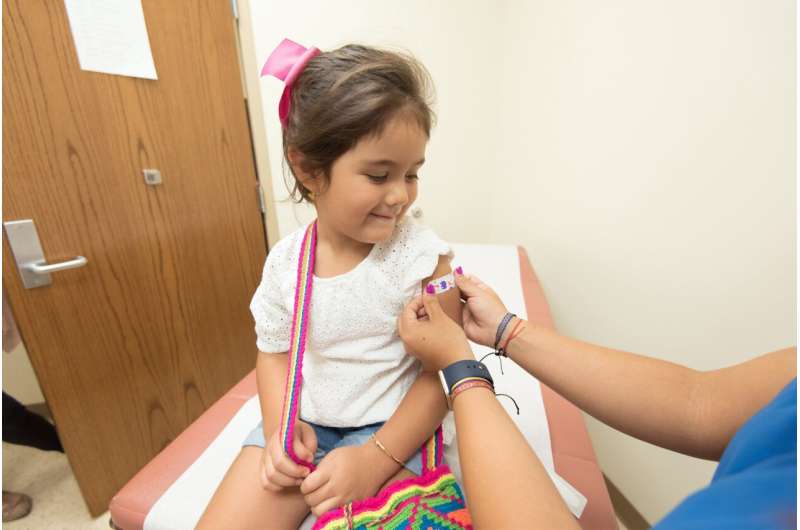This article has been reviewed according to Science X's editorial process and policies. Editors have highlighted the following attributes while ensuring the content's credibility:
fact-checked
peer-reviewed publication
trusted source
proofread
New policy statement proposes bold reforms to improve children's access to health care

Today, the American Academy of Pediatrics calls for sweeping changes to Medicaid and the Children's Health Insurance Program (CHIP) to provide more consistent and equitable coverage and ensure children can access the care they need to grow and thrive. These two programs provide invaluable and critical health care coverage for almost half of all US children and youth, most of whom would have no insurance without them.
In a new policy statement, "Medicaid and the Children's Health Insurance Program: Optimization to Promote Equity in Child and Young Adult Health," the AAP proposes automatic enrollment of newborns in a single health insurance program (combining Medicaid and CHIP) with an option to opt out if families have other health insurance, such as employer-provided insurance. The policy statement further calls for changes to make children's access and care more consistent across states, mitigating many existing geographic and racial disparities.
The policy statement will be published online in Pediatrics on Friday, Oct. 20, during the 2023 AAP National Conference & Exhibition in Washington, D.C., followed by its publication in the November 2023 print edition of Pediatrics. A soon-to-be released technical report addresses Medicaid and CHIP background; state program and payment variations; Medicaid for specific populations; program innovations and waivers; and special Medicaid coverage and initiatives.
Policy statements created by AAP are written by medical experts, reflect the latest evidence in the field, and go through several rounds of peer review before being approved by the AAP Board of Directors and published in Pediatrics.
The authors will discuss the policy statement during a conference session.
"The existing patchwork of state Medicaid plans work well for some, but not all children, and leads to inequities and obstacles for families to obtain and keep their medical coverage," said Jennifer D. Kusma, MD, MS, FAAP, a co-author of the statement, written by the AAP Committee on Child Health Financing. "The AAP proposes combining the best of the federal programs in place now, which would increase all children's access to health care and build a solid foundation for healthy lives. Ultimately, all of society benefits when children and families are thriving and able to get their routine, preventive and urgent health care needs addressed."
The policy statement proposes changes that would assure uniform state eligibility levels, enrollment and retention, benefits, standards of care, and payment.
"The goal is to achieve more equitable, higher quality, and more comprehensive health care," said Jean L. Raphael, MD, MPH, FAAP, a co-author of the policy statement. "These reforms would integrate mental health prevention and promotion work into pediatric care, for example. This would help greatly in addressing the mental health crisis among youth that we are seeing today."
Medicaid, which has been in place since 1965 and expanded over time, offers a safety net for children from low-income families receiving government assistance; children and adults with disabilities; elderly low-income populations; people with vision impairment lacking other health insurance; and children in foster care.
Unlike Medicare, which is fully funded by the federal government, Medicaid has a joint federal-state funding arrangement that allows states broad discretion over eligibility, benefits, enrollment, and payments while meeting current federal minimums and guidelines.
CHIP was introduced in 1997 to insure children with household incomes above the state's Medicaid income eligibility threshold but too low to afford private insurance. Medicaid and CHIP have similarities and differences in financing and operation and the statement calls for combining the two programs into one.
The proposed reforms would require legislation, regulation, and systems changes.
The AAP recommends:
- Automatic enrollment of all newborn infants at birth that will ensure access to health care benefits during critical newborn hospitalization and post-discharge periods. Parents can opt out of coverage if the infant has another source of health insurance.
- Universal eligibility for all children up to age 26 years who lack other sources of health insurance, through a single program that combines Medicaid and CHIP.
- Increases in the federal share of funding of the Medicaid/CHIP programs, especially for all direct patient care, to eliminate state variations that contribute to unequal access to care.
- Federal minimum rate schedule assuring payment at least equitable to prevailing Medicare rates
"It is time to do the difficult and necessary work to eliminate longstanding impacts of systemic racism within public insurance programs for children," James M. Perrin, MD, FAAP, a co-author of the policy statement. "The AAP recognizes that structural change will not be simple and cannot undo past harms, but it would provide meaningful improvement in the lives of all children moving forward."
More information: American Academy of Pediatrics Proposes Bold Reforms to Improve Children's Access to Health Care, Pediatrics (2023).





















